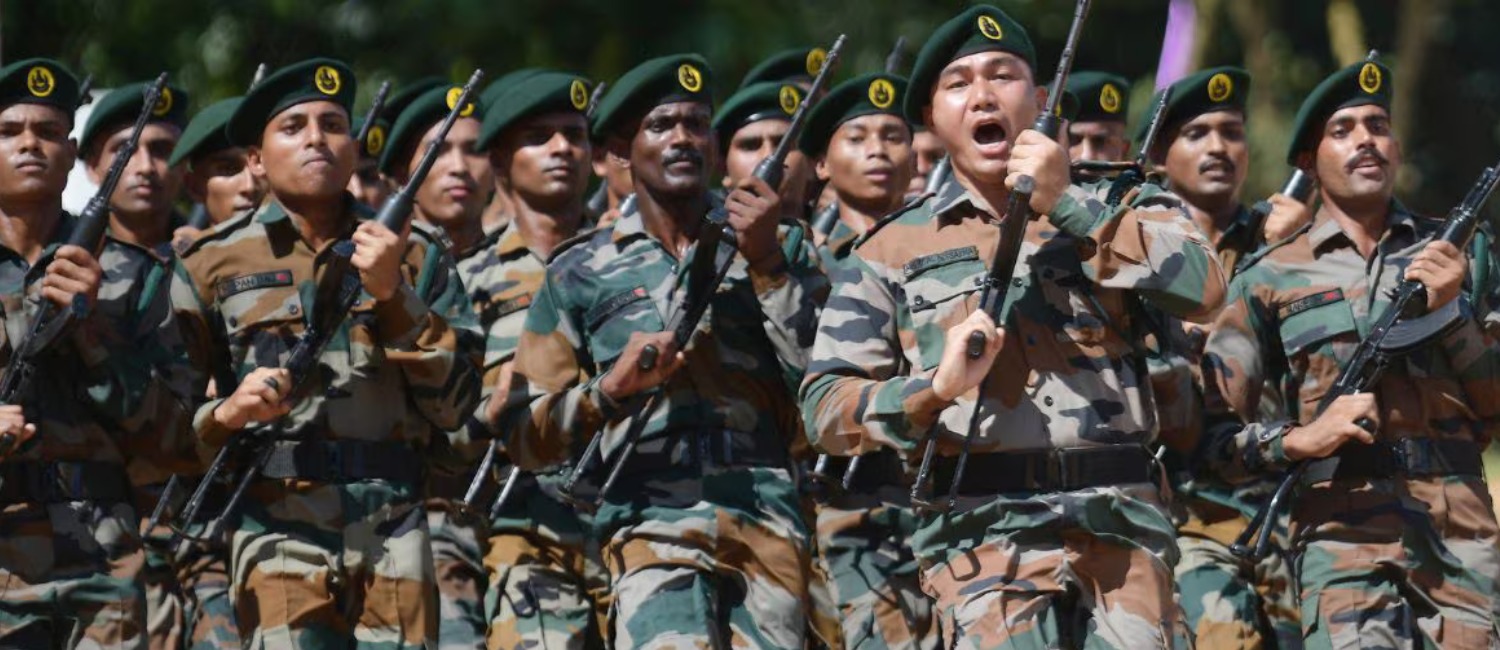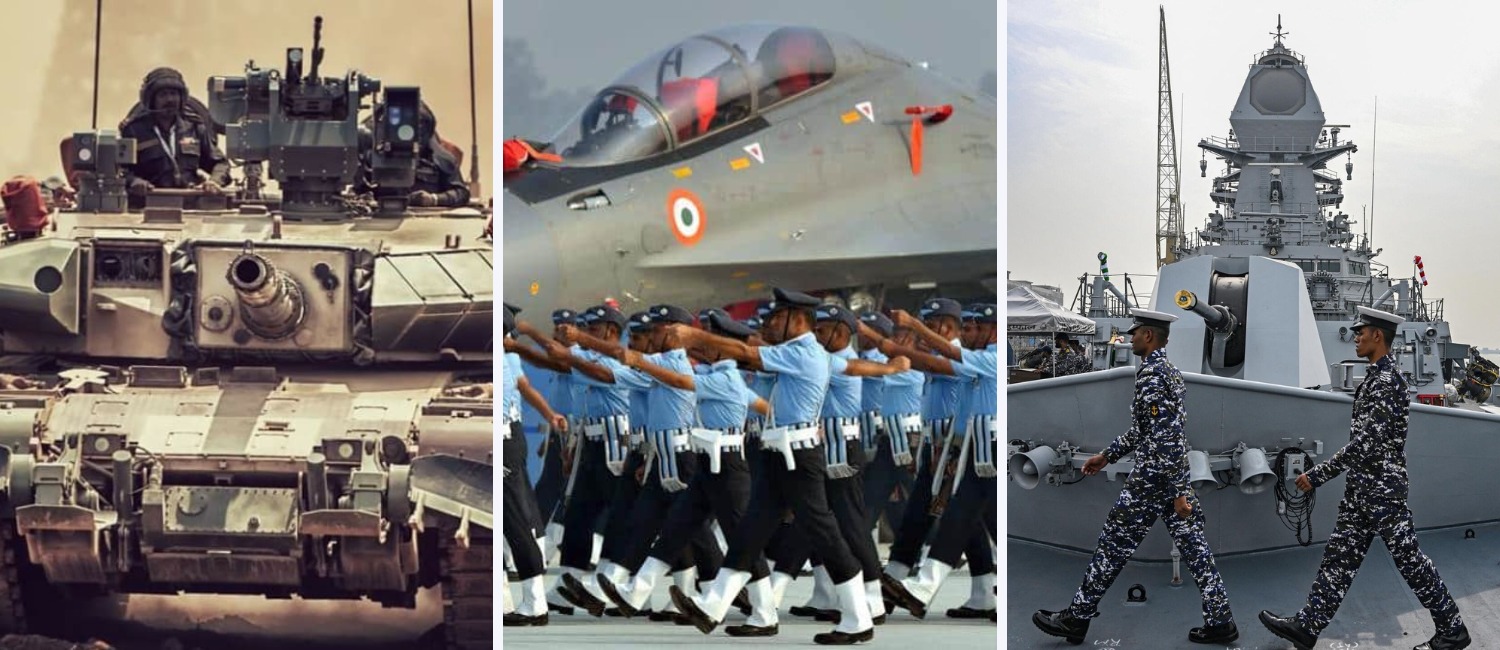A few months ago, I met Arjun, a Class 12 student from Delhi, brimming with energy and clarity. “Ma’am,” he said, “I don’t want a regular desk job. I want to serve the nation. I want my life to mean something bigger.” His father, though proud, looked unsure. “Will this career give him stability? Will he have opportunities to grow, like in tech or finance?”
This conversation isn’t rare. In fact, it reflects the growing dilemma many young Indians and their families face today. While the Indian Army has always been seen as a symbol of pride, duty, and discipline, the question now is—does it still make sense as a career choice after Class 12?
As a career strategist, I’ve worked with students exploring every path—from AI engineering to entrepreneurship. But the path of service—especially one that begins early—is a uniquely powerful one. And in today’s evolving world, the Indian Army isn’t just about uniforms and parades. It’s about leadership, cutting-edge technology, and global relevance.
So if you or your child is considering a life in uniform, this blog will break down everything you need to know—global trends, emerging skills, opportunities after 12th, and what the future really holds for Indian Army aspirants.
Before jumping to exams and salaries, let’s understand how the role of a soldier is evolving globally.
Global Shifts Shaping Army Careers Today
When I sit down with students curious about the Army, I often say: “Your choice to serve is more global than you think.” The Indian Army doesn’t exist in isolation. It’s part of a larger world where military strategy, technology, and diplomacy are constantly evolving.
Let’s explore three key global trends influencing Indian Army careers and why students after 12th should care.
Trend | What’s Changing | Why It Matters for Students |
Hybrid Warfare | From traditional battles to cyber, psychological, and drone warfare | Skills in IT, cybersecurity, and intelligence are in high demand |
Peacekeeping & Diplomacy | India is a top contributor to UN peacekeeping forces | Training now includes crisis management and cultural diplomacy |
Defense Tech Modernization | Push for indigenisation, AI-based systems, UAVs | Engineers and tech enthusiasts can serve in R&D and modern combat roles |
1. Rise of Hybrid Warfare & Asymmetric Threats
Today’s soldiers are no longer fighting just on land — but in cyber, information, and psychological battlegrounds.
- According to the Ministry of Defence Annual Report 2023, the Indian Armed Forces are now focusing on hybrid threats, especially from cross-border terror, cyberattacks, and drone warfare.
What it means: The Indian Army is actively recruiting talent with skills in IT, cybersecurity, electronic warfare, and intelligence—areas that go far beyond traditional battlefields.
2. Growing Role of Peacekeeping & International Collaboration
India is now a leading contributor to UN Peacekeeping Missions, making Army service not just national, but international in impact.
- As of 2024, India has deployed over 5,900 peacekeepers across 9 UN missions (United Nations Peacekeeping Fact Sheet).
- This positions India among the top 3 global contributors.
What it means: Army professionals today are trained in diplomacy, cultural sensitivity, crisis management, and working with international forces—essential skills for global engagement.
3. Push Toward Indigenous Defense Tech & Modernization
India’s defense modernization is in full swing, and it’s opening up exciting career opportunities in R&D, AI, and tech-integrated combat.
- The Defence Acquisition Procedure (DAP) 2023 promotes ‘Make in India’ with 75% of the defense capital procurement budget reserved for Indian firms.
- DRDO and private players like Tata Advanced Systems are collaborating to develop next-gen weapons, AI-based battlefield systems, and UAVs.
What it means: Students with engineering, robotics, and data science aspirations can now serve the nation through tech-driven roles within the Army ecosystem.
Where These Trends Intersect
These shifts aren’t isolated—they’re deeply interconnected. As warfare evolves, the need for tech-enabled, globally aware, and adaptable soldiers becomes more urgent. From cyber command units to peacekeeping boots on the ground, Army careers are now as much about strategy and intellect as they are about strength and discipline.
Tech-Driven Boots on the Ground: How the Indian Army Is Reinventing Itself
When I sat down with a Class 12 student last month—bright-eyed and dreaming of wearing the olive green—his biggest concern wasn’t the physical endurance test. It was this:
“Ma’am, I keep hearing the army uses AI now. I don’t even know how to code!”
That conversation made something very clear: today’s Indian Army isn’t just about grit and glory. It’s about data, drones, and digital warfare. The battlefield isn’t just boots on terrain anymore—it’s bytes, bots, and bandwidth.
AI is now the silent sentinel at India’s borders—spotting threats, interpreting terrain data, and predicting enemy movements faster than any human could.
Add to that the rise of autonomous vehicles, satellite surveillance, and cyber operations, and it’s clear: this is no longer the Army your grandfather knew. It’s part tech lab, part command post.
So what?
For today’s students, this means your love for coding, drones, or design can now be part of national service. You don’t have to choose between tech and the uniform—you can bring both to the table.
1. Digital Combat Simulations: Training the Mind Before the Battlefield
At premier academies like NDA (National Defence Academy) and IMA (Indian Military Academy), physical drills are now paired with immersive virtual warfare simulations. These tools help cadets learn battlefield strategy, convoy management, and tactical decision-making in real-time scenarios.
Think of it like a warzone video game—only much more serious and built with military-grade intelligence. This tech-first training sharpens judgment, risk analysis, and situational awareness before a cadet even sees live action.
And the best part? It builds mental agility, a trait now as important as stamina.
2. AI-Powered Surveillance & Terrain Mapping
Artificial Intelligence is helping soldiers see what the naked eye can’t. Whether it’s analyzing satellite imagery, detecting intrusions along the border, or predicting movement through terrain heatmaps, AI is a silent but powerful ally.
For instance, the Indian Army’s AI Centre of Excellence in Mhow is developing tools to monitor high-altitude areas and identify threats using real-time imaging and automated alerts.
This isn’t just about data—it’s about predicting danger before it strikes, which could save hundreds of lives.
3. Robotics in Warfare: Less Risk, More Precision
What if a robot could defuse a bomb or scout enemy territory before a soldier had to? That’s already happening. Units now use robotic surveillance crawlers and remotely operated vehicles (ROVs) for bomb detection and mine clearance, especially in conflict-prone zones like Kashmir.
And these aren’t future dreams—they’re in action today, quietly reducing risk and improving mission efficiency. Robotics is redefining the role of a soldier from executor to strategist.
4. Cyber Defence Units: Protecting Digital Borders
War today isn’t just fought on land—it’s fought on servers, systems, and social media feeds. That’s why the Indian Army has dedicated Cyber Defence Divisions that focus on protecting sensitive military data, thwarting phishing attempts, and preventing cross-border cyber intrusions.
With rising cyberattacks from hostile nations, these roles are now as crucial as boots on the ground. If you’re tech-savvy, there’s a place for your skills in uniform—keyboard and all.
5. Collaborations with IITs, ISRO, and Defence Startups
To stay ahead, the Army isn’t doing it alone. It’s collaborating with tech institutions like IIT Madras, ISRO, and defence startups under the iDEX initiative to co-develop indigenous weapons tech, communication systems, and AI models.
This means soldiers and engineers are working shoulder to shoulder—one with a rifle, the other with a laptop—proving that national service now takes many forms.
For instance:
- IIT Kanpur is working with the Army on anti-drone technologies.
- Tonbo Imaging, a Bengaluru-based startup, has developed night-vision surveillance systems now used along the LAC.
- ISRO supports satellite-based reconnaissance and GPS tracking in remote terrains, enhancing troop coordination.
These partnerships are giving soldiers cutting-edge tools to make quicker, smarter, and safer decisions on the field.
Key Takeaway: The Indian Army is no longer just about muscle—it’s about minds empowered by machines. Whether you love robotics, aspire to be a coder, or dream of a life of service, there’s space for all kinds of talent in this new-age defence ecosystem.

Job Demand & Hiring Trends
Just a few weeks ago, a parent asked me during a webinar,
“Preethi, is there really job security in the Indian Army anymore?”
It’s a valid concern—and one I hear often. But here’s the truth I always share: not only is the demand for Army officers still strong, it’s becoming more diverse and future-ready.
Let’s break it down with the numbers:
👉 According to the Ministry of Defence’s 2023 report, the Indian Army is recruiting over 90,000 personnel annually across ranks to meet modernization and strategic demands.
👉 The Agniveer scheme, launched in 2022, attracted over 25 lakh applications in its first year—a clear sign of high interest and intense competition.
👉 And it’s not just the traditional infantry anymore. Roles now include tech, logistics, intelligence, and cyber warfare, requiring far more than just physical strength.
Not Sure Yet? Start Short, Think Long
If your child isn’t ready to commit to 20+ years in uniform, that’s okay. Programs like Agniveer offer a shorter 4-year stint—ideal for testing the waters. It’s a smart checkpoint for those still figuring out their career direction.
Some discover their passion and get absorbed into permanent service. Others exit with experience, discipline, and priority in government jobs and further education.
Here are the key hiring and demand trends that are shaping the future of Army careers after 12th:
1. The Rise of Agnipath & Agniveer: Entry for the New-Gen Soldier
The Agnipath Scheme introduced a short-term recruitment model for soldiers between 17.5 and 21 years. Under this, Agniveers are enrolled for four years with an opportunity for 25% to be retained in the regular cadre.
🔹 In 2023, the Army announced 25,000+ Agniveer vacancies, making it one of the largest recruitments in the country.
🔹 It offers a monthly package of ₹30,000–40,000 with allowances, plus a Seva Nidhi package of ₹11.71 lakh at the end of service.
This model offers both early exposure to military training and a launchpad for future government or private careers.
2. Focus on Tech-Enabled Roles: Beyond the Battlefield
With digital warfare and surveillance becoming core to national defense, there’s now strong demand for youth skilled in:
- Computer science
- AI and robotics
- Satellite communication
- Cybersecurity
For instance, the Corps of Signals and Military Intelligence units actively seek Class 12 pass-outs with tech aptitude or NCC experience, even offering specialized training post-recruitment.
This means that tech-savvy students now have a real edge, even without an engineering degree.
3. Officer-Level Recruitment Through NDA & TES: Still Prestigious, Still in Demand
The NDA exam (held twice a year by UPSC) remains one of the most respected paths into the Army post-12th. Each cycle sees over 6 lakh applicants for about 370 officer-level seats.
Meanwhile, the Technical Entry Scheme (TES) is exclusive to Class 12 science students with PCM and 60%+ marks. TES cadets get trained at the OTA Gaya and then pursue engineering through the Army.
This pathway offers a secure, high-status military career, blending leadership with lifelong learning.
Entry Scheme | Eligibility | Age Limit | Selection Process | Training Location | Service Duration | Post-Training Role | Salary / Benefits |
NDA (National Defence Academy) | Class 12 (Any Stream) + UPSC NDA Exam | 16.5 to 19.5 years | Written Exam (UPSC) + SSB Interview + Medical | NDA Khadakwasla → IMA/AFA/INA | Full-term Commission | Permanent Commissioned Officer | ₹56,100/month starting pay + allowances, perks, pension |
TES (Technical Entry Scheme) | Class 12 (PCM) with 60%+ marks | 16.5 to 19.5 years | Shortlisting based on PCM %, SSB Interview + Medical | OTA Gaya + Engineering College (e.g., CME Pune) | Full-term Commission | Permanent Commissioned Officer (Technical Branch) | Same as NDA: ₹56,100/month + perks, free BTech, military career |
Agniveer (Agnipath Scheme) | Class 10 / Class 12 (depending on post) | 17.5 to 21 years | Physical Test + Medical + Written Exam (based on post) | Regimental Training Centres | 4 Years Contractual | Agniveer Rank (Soldier) | ₹30,000–40,000/month + allowances + ₹11.71 lakh Seva Nidhi after 4 years |
4. Diversity Hiring: More Women Joining Ranks
The Army is gradually opening up more roles for female candidates, especially in signals, engineering, legal, and medical corps.
🔹 In 2022, over 1,500 women joined various officer and junior commissioned roles—up nearly 30% from the previous year.
🔹 And since 2021, women can appear for NDA, opening up more officer-level opportunities.
For aspirants looking for equal opportunities and service to the nation, this is a powerful step forward.
5. Demand in Specialized Units: Border, Intelligence & Strategic Forces
With India’s 2-front challenge (China & Pakistan) and increasing international peacekeeping missions, the Army is actively recruiting for:
- Special forces like Para SF
- Border Monitoring Taskforces
- UN Peacekeeping deployments
For example, Indian troops in UN missions in Congo, Lebanon, and Sudan require language skills, diplomacy, and quick adaptability, giving a global dimension to Army careers.
Bottom line: Whether you’re dreaming of action on the front lines or behind-the-scenes operations, the Indian Army is expanding and diversifying its hiring like never before. And if you’re willing to learn, lead, and serve—it might just be the perfect calling.
Emerging Skills Required
When I speak to students and parents about Army careers, many still imagine the selection process as purely physical—“run fast, lift weights, salute smart.”
But let me tell you—that’s just one piece of the puzzle.
Gone are the days when Army prep meant only running laps. Today, success depends just as much on mindset and modern skills.
The Indian Army is now a technology-led, strategy-driven, globally connected force. If you’re aiming to join after Class 12, you’ll need more than stamina—you’ll need sharp thinking, adaptability, and digital awareness.
🧠 Situational Judgment & Quick Thinking
Officers are often required to make life-impacting decisions in seconds. This isn’t about memorizing facts—it’s about clarity under pressure.
Reflect: Do you stay calm when things go sideways, or does panic take over?
💻 Digital Awareness
Basic tech literacy is no longer optional. Whether it’s navigating battlefield tech, handling UAVs, or reading digital maps—21st-century warfare demands it.
Reflect: Can you pick up new tech tools quickly, or do you avoid them?
🗣️ Communication & Leadership
From leading troops to negotiating with civilians, strong communication builds trust and ensures smooth coordination—even in chaos.
Reflect: When working in a group, do people naturally turn to you for direction?
🌍 Global Perspective & Cultural Sensitivity
With UN missions and global collaborations, Army officers often operate in diverse environments.
Reflect: Are you curious about other cultures, or do unfamiliar situations make you uncomfortable?
🧭 Emotional Intelligence & Mental Resilience
Handling high-stress environments while staying grounded is critical. It’s not just about toughness—it’s about staying human under strain.
Reflect: When under stress, do you shut down—or rise to the challenge?
So if you’re dreaming of olive green, here are the must-have skills that will help you stand out and succeed:
1. Strategic Thinking & Leadership
Whether you’re leading a patrol in Siachen or coordinating disaster relief in Assam, quick decisions under pressure can save lives.
The SSB interview process is built around this. Group tasks, command tasks, and psychological tests are designed to assess how you lead, adapt, and analyze situations.
Example: I once mentored a student who cracked NDA by mastering the art of asking “why” during group discussions. That simple curiosity helped him lead with insight—not just enthusiasm.
Takeaway: Start training your brain for chess, not just pushups. Play strategy games, follow defense news, and practice problem-solving under time limits.
2. Physical & Mental Endurance
Yes, your stamina still matters—but not just for the 2.4 km run. What’s equally important is your mental resilience.
SSB assesses mental toughness through tasks that simulate pressure, isolation, and even failure. Medicals, too, are strict—especially for heart, vision, and spine health.
Example: One of my students failed her first medical examination due to flat feet—but didn’t give up. She worked with physiotherapists, reapplied, and cleared it the next cycle.
Takeaway: Start early with fitness. Train like a sportsperson, but also learn how to bounce back from setbacks—it’s half the battle.
3. Technical Proficiency
Modern regiments now use AI-powered drones, battlefield sensors, encrypted radio tech, and more. Whether you’re applying through NDA or Agnipath, tech-savviness is no longer optional—especially for roles in Signals, EME, and Intelligence.
Example: The Army’s tech units often collaborate with IITs and DRDO to train recruits in machine learning and satellite mapping. Many TES students end up as engineers designing real-time combat tech.
Takeaway: Even if you’re from a non-tech background, brush up on digital basics. Learn about cybersecurity, AI tools, or electronics—YouTube and NPTEL courses are great starting points.
4. Communication Skills
In high-stakes situations, a clear command can mean the difference between chaos and control.
Army officers must communicate not just with subordinates, but also with civilians, international agencies, and fellow units—sometimes in multiple languages or dialects.
Example: During UN Peacekeeping missions, Indian officers often coordinate with 20+ nationalities. Diplomatic clarity, cultural empathy, and calm under pressure become essential.
Takeaway: Sharpen your speaking and listening skills. Practice mock briefings, record yourself, join debate clubs or NCC activities where clear communication is key.
Bottom line: The Indian Army is looking for more than just brave hearts—it wants brave, sharp, and future-ready minds. So, if you’re preparing to serve, start building these skills today. Because the battlefield of tomorrow begins in your mindset today.
Tip: Encourage your child to start working on overall personality development, not just academics. Activities like NCC, sports, and debate clubs are great grooming grounds.

Future Outlook & Predictions
Whenever I guide students preparing for the NDA or Agnipath, one common question from parents is:
“But what after the Army?”
It’s a fair concern. And here’s the truth: an Army career today doesn’t just open one door—it opens many.
Whether you serve for 4 years or 20, the Indian Army shapes individuals who are adaptable, disciplined, and leadership-ready—qualities that transfer well into civilian careers and higher education.
🔹 Post-Agnipath / NDA: Short-Term Career Pathways
For those entering through Agnipath, the 4-year stint is designed to offer experience, exposure, and a chance to test one’s calling. At the end of service:
- 25% may be retained in the regular cadre based on performance.
- The rest exit with a Seva Nidhi package (approx ₹11.7 lakh, tax-free), a skill certificate, and priority in CAPF, police, and government roles.
- Many also go on to pursue higher studies with credit support and age relaxations.
For NDA cadets who decide not to pursue a full military career post-training or early into service, the foundational training prepares them for:
- Administrative roles
- Corporate leadership programs
- Civil services
- Higher education in India or abroad
📌 Transferable skills like time management, team leadership, and crisis handling make Army-trained youth highly attractive to recruiters.
🔹 Long-Term: Exit After 20+ Years or Retirement
For those who stay the course, an Army career offers:
- Structured promotions and pay growth—starting at ₹56,100/month (Level 10) plus perks like accommodation, travel concessions, medical cover, and pension.
- Post-retirement career options in:
- Defense consultancy
- Corporate security and operations
- Government advisory roles
- Teaching and training positions
- Defense consultancy
Many veterans also launch startups or pursue second careers with their Army-honed skillsets and strong networks.
Other Career Options:
1. Post-Retirement Corporate Roles
The discipline, strategy, and team management you gain in the Army are exactly what corporations need—especially in logistics, HR, cybersecurity, and security consulting.
Example: Ex-army officers now head departments in companies like TCS, L&T, and Adani Defence.
Takeaway: Build your leadership and communication skills during service—it’ll translate into top-tier roles in civilian industries.
2. International Peacekeeping Missions with the UN
India is one of the top troop contributors to UN peacekeeping, and this opens a global stage for officers and soldiers to serve abroad in conflict zones and humanitarian operations.
Example: In 2024, over 5,900 Indian personnel were part of 9 UN missions—ranging from Congo to Lebanon.
Takeaway: Keep up your diplomatic skills and cultural awareness. These missions offer international exposure, extra incentives, and lifelong networks.
3. Opportunities in Civil Services
Many Army personnel prepare for UPSC exams while in service or after retirement—and they succeed.
Example: Over the past 5 years, there’s been a steady rise in ex-officers cracking UPSC to become IAS, IPS, or IFS officers.
Takeaway: Use your time in the Army to build a strong understanding of administration, governance, and current affairs—perfect stepping stones for civil services.
4. Entrepreneurial Ventures
From defence consultancies and survival training academies to motivational speaking and ed-tech, many ex-Army professionals become entrepreneurs.
Example: Startups like CLAW Global (by Special Forces veterans) are teaching survival skills, adventure sports, and even training youth with disabilities.
Takeaway: Use your Army experience to create impact-driven businesses. Your story, skills, and credibility will set you apart in any market.
In short, a career in the Indian Army today doesn’t end with retirement—it evolves into new leadership avatars. From serving the nation to leading change in the world beyond, the future is as bold as your ambitions.
Still unsure if a defence career is right for your child?
What This Means for Aspiring Professionals?
As someone who works closely with students and families navigating big career decisions, I often get this question:
“Is joining the Army after 12th the right move?”
After looking at the trends, emerging skillsets, global relevance, and future scope—here’s what I tell them:
If your child is driven by service, resilience, and leadership—not just salary—this career may fulfill more than just ambition.
For the right kind of student, the Army offers not just a job—but a strong foundation for life. It builds character, clarity, and confidence. Whether you stay for 4 years or 30, the experience leaves you sharper, stronger, and ready for what comes next.
And that’s a future worth preparing for.
Let’s break it down.
- Purpose with Prestige- The Indian Army isn’t just a job. It’s a calling. If your child values discipline, duty, and a deep sense of service, this career offers unmatched personal satisfaction. Unlike corporate jobs that may feel transactional, this path builds character and purpose from Day One.
- Opportunities Beyond Uniform- The training, leadership, and resilience developed in the forces open doors beyond the battlefield. Whether it’s a post-retirement role in the private sector, cracking the UPSC, or even launching a startup—Army experience is a launchpad, not a limitation.
- A Clear Roadmap with Early Entry- One of the biggest wins? Students can start preparing right after Class 10 or 12. With entrance exams like NDA or TES, your child can enter the force by 18–19 years—while their peers are still exploring what to do next.
- Early Financial Independence- Add to this the structured pay, subsidized perks, and long-term pension benefits, and you’ve got a path that ensures dignity with stability—a rare combination in today’s job market.
A Career that Evolves with the Nation- With tech partnerships, international missions, and modernization in full swing, today’s Indian Army is far from traditional. It’s a forward-looking force. If your child is excited by technology, geopolitics, or leadership—this is where all of it converges.
How NextMovez Can Help You or Your Child Choose the Right Path?
Not every student is ready to jump into the Army path blindly—and that’s okay. Our role is to bring clarity before commitment.
As a career strategist and mentor, I know that the Indian Army path is unique—it demands more than just preparation. It calls for clarity, grit, and the right guidance at the right time. And that’s exactly where NextMovez steps in.
✅ 1:1 Mentorship with Defence Experts
We connect students with real-life defence officers and SSB-qualified mentors who’ve actually walked this path. From NDA prep to understanding life in uniform—we decode it all through real conversations, not theory.
✅ Personalised Roadmaps from Class 9 Onward
Not sure when to start or which entry route fits best? Whether it’s NDA, TES, or Agnipath—we build a customized roadmap based on your child’s academics, strengths, and long-term goals.
✅ Aptitude & Personality Profiling
We use global tools to assess leadership traits, decision-making patterns, and risk tolerance—so the Army decision isn’t based on guesswork, but guided by self-awareness.
✅ College vs Army Decision Framework
Torn between engineering college and Army TES? Or wondering if NDA is the right next step? Our experts offer real-world comparisons—cost, ROI, lifestyle, timelines—to make the picture clearer for both parents and students.
✅ Parent + Student Workshops
We host regular webinars and workshops designed for joint decision-making. Because alignment comes when both sides understand the path ahead.
Final Word:
Choosing the Indian Army is a bold and beautiful decision—but it needs courage, clarity, and careful planning. At NextMovez, we don’t just help students crack exams—we help them build clarity, courage, and a career they can own with pride.
Resources & References Used
- UPSC NDA Exam Details
- Indian Army TES Entry Info
- Ministry of Defence Recruitment Statistics, 2023
- Supreme Court Judgment on NDA Entry for Women (2021)
- Pay Matrix & Allowances: Sixth & Seventh Pay Commission Reports






















